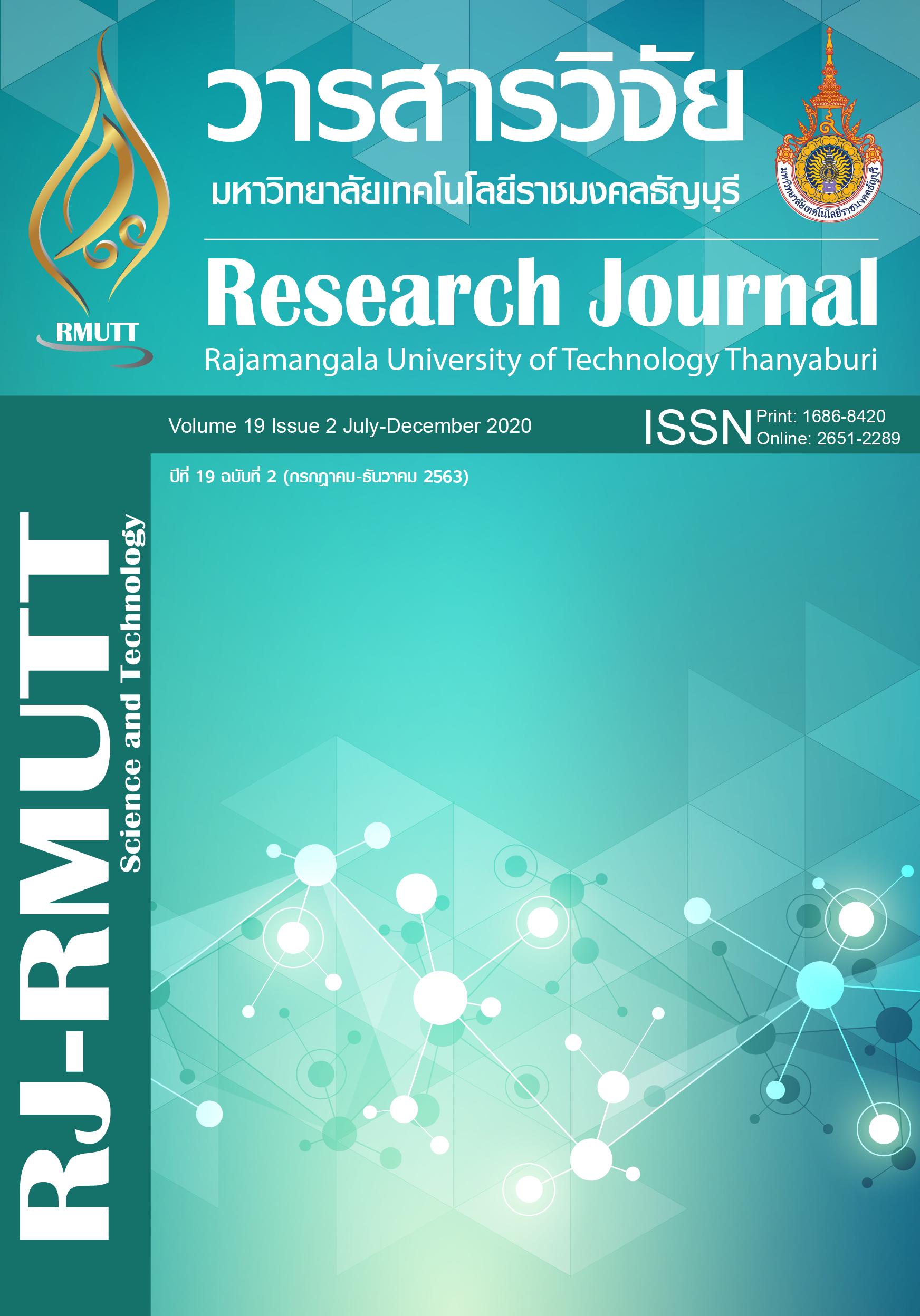Structural and Mechanical Properties of Cubic Na2O: First-Principles Calculations
Main Article Content
Abstract
This work presents the investigation of the structural and mechanical properties of Na2O in cubic structure (hereafter denoted as cubic Na2O) by using the first-principles calculations within the local density approximation (LDA) and the generalized gradient approximation (GGA) in the functional form by Perdew-Wang 91 (PW91). The structural parameters such as the equilibrium volume (V0), the bulk modulus (B0), and its pressure derivative (B’0) can be obtained by fitting the calculated energy (E) and volume (V) data with the third-order Birch - Murnaghan’s equation of state whereas the elastic constants can be obtained from the stress-strain approach. The calculated equilibrium structural parameters and all three elastic constants (C11, C12, and C44) show a good agreement with the experimental and other theoretical values. All elastic constants and bulk moduli calculated from LDA are slightly larger than those values calculated from GGA, by the reason of the lattice constant calculated from LDA is slightly smaller than that calculated from GGA. By using the calculated elastic constants and Born’s criteria, the cubic Na2O was found to be mechanically stable at ambient pressure. Consistent with the calculated elastic constants (Cij), other elastic moduli such as bulk modulus (B), shear modulus (G), Young’s modulus (Y), and Poisson ratio (v) of cubic Na2O can be obtained by Voigt–Reuss–Hill (VRH) method. Because the B/G and v values can be used to determine the brittleness and ductility of materials, our calculated B/G and v values indicate that cubic Na2O behaves as a brittle material at ambient pressure. Furthermore, the hardness of cubic Na2O can also be obtained by using G/B and G values. The details of the structural and mechanical properties calculations for cubic Na2O were presented and discussed.
Article Details

This work is licensed under a Creative Commons Attribution-NonCommercial-NoDerivatives 4.0 International License.
References
Jamal M, Venugopal G, Shareefuddin M, Chary MN. Sodium ion conducting glasses with mixed glass formers NaI–Na2O–V2O5–B2O3: application to solid state battery. Mater Lett. 1999;39(1):28-32.
Cho KI, Lee SH, Cho KH, Shin DW, Sun YK. Li2O–B2O3–P2O5 solid electrolyte for thin film batteries. J Power Sources. 2006;163(1):223-8.
Lee KB, Beaver MG, Caram HS, Sircar S. Performance of Na2O promoted alumina as CO2 chemisorbent in sorption-enhanced reaction process for simultaneous production of fuel-cell grade H2 and compressed CO2 from synthesis gas. J Power Sources. 2008;176(1):312-9.
Zintl E, Harder A, Dauth B. Gitterstruktur der oxyde, sulfide, selenide und telluride des lithiums, natriums und kaliums. Zeitschrift für Elektrochemie und angewandte physikalische Chemie. 1934;40(8):588-93.
Wu X, Zhang Y, Zhang J, Liu R, Yang J, Yang B, et al. High pressure X-ray diffraction study of sodium oxide (Na2O): Observations of amorphization and equation of state measurements to 15.9 GPa. J Alloy Compd. 2020;823:153793.
Dovesi R, Roetti C, Freyria-Fava C, Prencipe M, Saunders V. On the elastic properties of lithium, sodium and potassium oxide. An ab initio study. Chem Phys. 1991;156(1):11-9.
Shukla A, Dolg M, Fulde P, Stoll H. Towards a quantum-chemical description of crystalline insulators: a Wannier-function-based Hartree-Fock study of Li2O and Na2O. J Chem Phus. 1998;108(20):8521-7.
Moakafi M, Khenata R, Bouhemadou A, Khachai H, Amrani B, Rached D, et al. Electronic and optical properties under pressure effect of alkali metal oxides. Eur Phys J B. 2008;64(1):35-42.
Thompson M, Shen X, Allen PB. Density functional calculation of electronic structure and phonon spectra of Na2O. Phys Rev B. 2009;79(11):113108.
Hohenberg P, Kohn W. Inhomogeneous Electron Gas. Phys Rev. 1964;136(3B):B864-71.
Kohn W, Sham LJ. Self-Consistent Equations Including Exchange and Correlation Effects. Phys Rev. 1965;140(4A):A1133-8.
Kresse G, Furthmüller J. Efficient iterative schemes for ab initio total-energy calculations using a plane-wave basis set. Phys Rev B. 1996;54(16):11169-86.
Ceperley DM, Alder BJ. Ground State of the Electron Gas by a Stochastic Method. Phys. Rev. Lett. 1980;45(7):566-9.
Perdew JP, Zunger A. Self-interaction correction to density-functional approximations for many-electron systems. Phys Rev B. 1981;23(10):5048-79.
Perdew JP, Chevary JA, Vosko SH, Jackson KA, Pederson MR, Singh DJ, et al. Atoms, molecules, solids, and surfaces: Applications of the generalized gradient approximation for exchange and correlation. Phys Rev B. 1992;46(11):6671-87.
Monkhorst HJ, Pack JD. Special points for Brillouin-zone integrations. Phys Rev B. 1976;13(12):5188-92.
Birch F. Finite Elastic Strain of Cubic Crystals. Phys Rev. 1947;71(11):809-24.
Murnaghan FD. The compressibility of media under extreame pressure. Am J Math. 1944;49(2):235.
Kittel C. Introduction to Solid State Physics. USA: John Wiley & Sons, Inc; 1996.
Hill R. The Elastic Behaviour of a Crystalline Aggregate. Proc Phys Soc Sec A. 1952;65(5):349-54.
Reuss A. Berechnung der Fließgrenze von Mischkristallen auf Grund der Plastizitätsbedingung für Einkristalle. ZAMM. J Appl Math Mech. 1929;9(1):49-58.
Zintle E, Harder A, Dauth B. Lattice Structure of the oxides, sulfides, selenides and tellurides of lithium, sodium and potassium. Z Elektrochem. 1934;40:588.
Born M, Huang K. Dynamical theory of crystal lattices. Clarendon press; 1954.
Pugh S. XCII. Relations between the elastic moduli and the plastic properties of polycrystalline pure metals. The London, Edinburgh, and Dublin Philosophical Magazine and Journal of Science. 1954;45(367):823-43.
Tian Y, Xu B, Zhao Z. Microscopic theory of hardness and design of novel superhard crystals. Int J Refract Met H. 2012;33:93-106.

